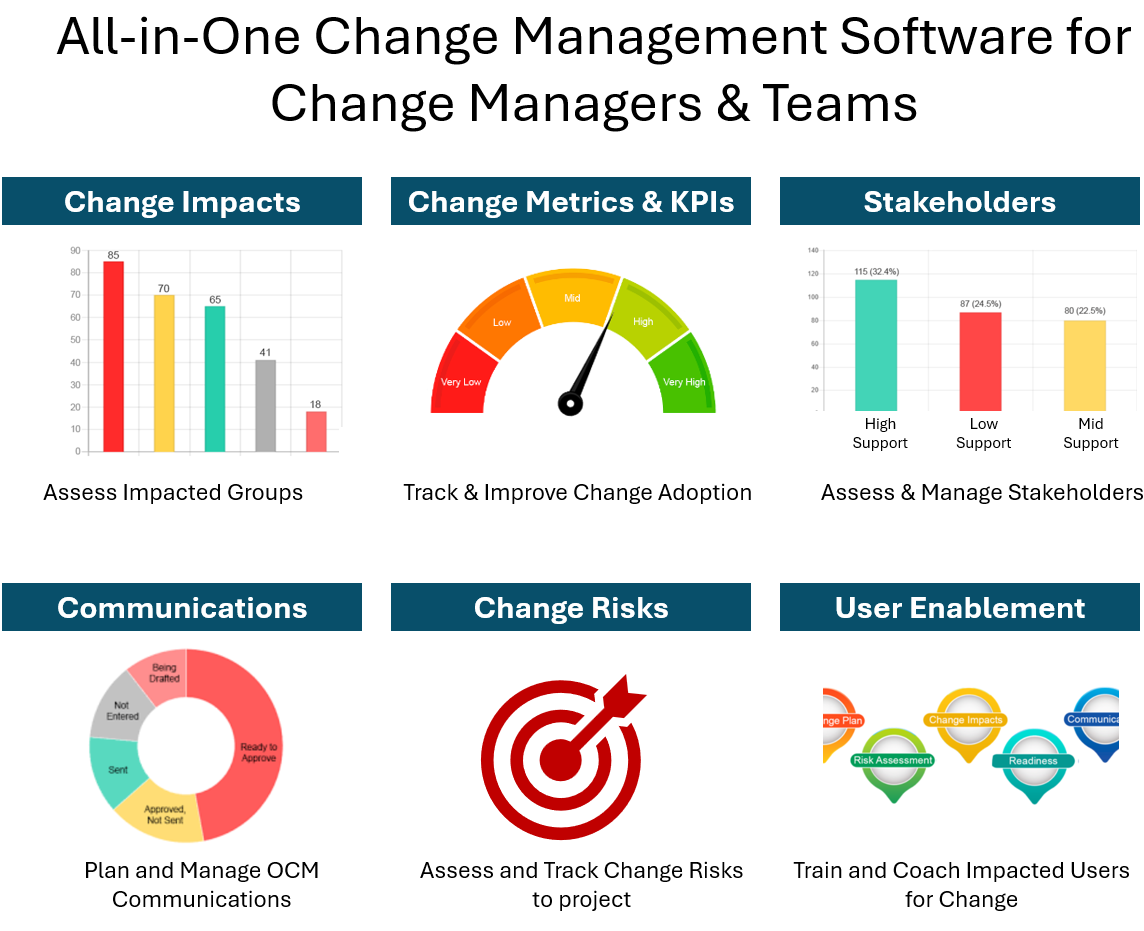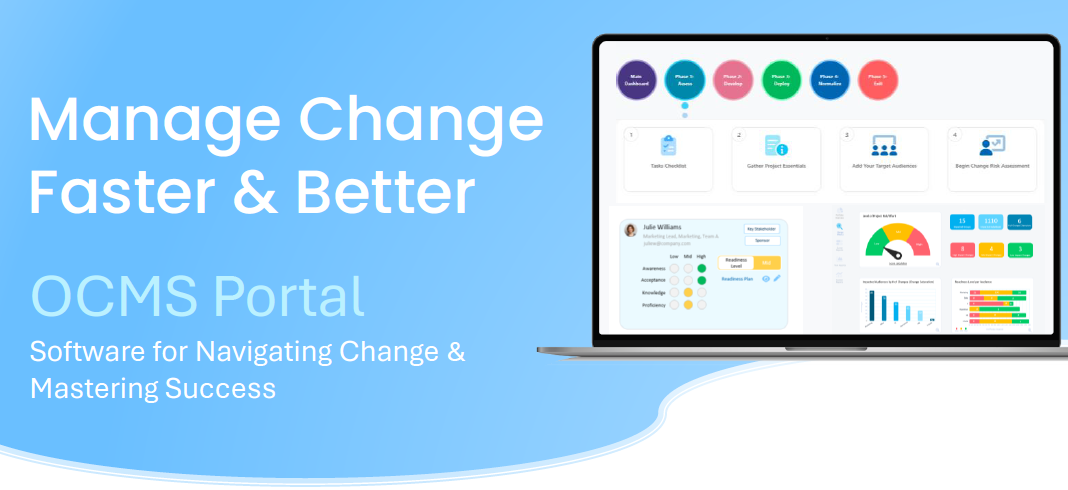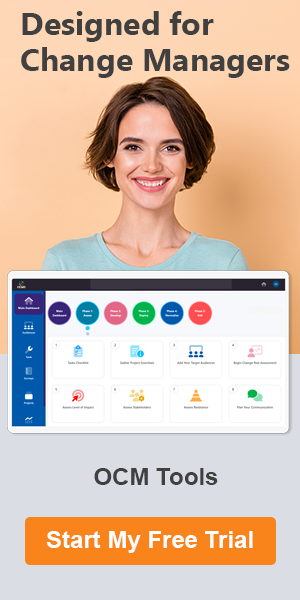Essential Project Stakeholder Management Techniques for Better Enterprise Initiatives
This article will arm you with valuable information about the world of project management and stakeholders and explore why it’s often a weak spot in an organization.
We’ll cover the importance of incorporating change management principles into your project stakeholder management plan to ensure successful change adoption and project ROI.
Project stakeholders, individuals or groups impacted by the project, can make or break its success, and their influence, opinions, and ultimately, their adoption of project changes, significantly impact the project’s outcome.

Enterprise projects are intricate ecosystems teeming with activity. From meticulous planning to meticulous execution, success hinges on the smooth interaction of various players. But often, a crucial element gets overlooked – project stakeholder management.
Watch a summary below:
Story Highlights
|
The Power of Project Stakeholders: Why They Matter
What’s the definition of a stakeholder in project management? Project stakeholders are individuals or groups who have a vested interest in the project’s outcome.
There are several stakeholder types in project management. When defining stakeholders in a project, it’s good to begin with this core list and then add more as needed.
The standard types of stakeholders in project management are:
- Executive Sponsors: They provide financial backing, champion the project, and remove roadblocks.
- Project & Change Mgmt. Team Members: They are the backbone of the project, responsible for completing tasks and delivering results.
- Key Stakeholders: Key stakeholders in a project include those impacted individuals who are critical to the project’s success.
- End Users/Impacted Individuals: Those who will ultimately utilize the project’s deliverables.
- Customers: External clients impacted by the project’s outcome.
Other types you might include in your definition of project stakeholders:
- Managers: They are managers or supervisors of impacted groups that may need slightly different project engagement than other project stakeholder types.
- Vendors: External vendors impacted by the project’s outcome.
- Change Champions/Agents: This definition of a stakeholder in project management includes impacted individuals who help enable their peers to adopt project changes.
Effective stakeholder management in project management involves identifying, understanding, and engaging these stakeholders throughout the project lifecycle. It ensures their needs are considered, concerns addressed, and their influence is harnessed for project success.
Do you have any questions about project stakeholders in project management or defining the types of stakeholders in project management? Please reach out and let us know.
Why Is People Management in Project Management a Common Weak Spot?
Despite its importance, enterprise project stakeholder management often falls short. This failure of properly managing people and projects and how they impact one another often leads to project failure or underperformance.
Here are some reasons stakeholder management in project management often misses the mark:
- Limited Stakeholder Identification: Failing in completely identifying stakeholders in project management can lead to misunderstandings and missed opportunities for collaboration.
- Poor Communication: Inconsistent or inadequate communication with key stakeholders in a project can breed frustration, misinformation, and ultimately, resistance to change.
- Unclear Expectations: Failure to set clear expectations about the role of stakeholders in project management, their responsibilities, and the project’s impact can lead to disappointment and disengagement.
- Change Management Overlooked: Focusing solely on project tasks and technical delivery without considering the human element of change can lead to stakeholder resistance and difficulty in sustaining project outcomes after implementation.
These shortcomings in people project management can significantly impact project success and lead to missed deadlines, budget overruns, and ultimately, project failure.
The Missing Piece: Change Management for an Effective Project Stakeholder Management Plan
Change management, the structured process of guiding individuals and teams through transitions, holds the key to effective stakeholder management in projects. Here’s why:
- Understanding Stakeholder Needs: Change management principles emphasize understanding project management and stakeholders’ needs, concerns, and potential resistance points. This helps tailor project communication and engagement strategies accordingly.
- Building Relationships: Change management fosters building strong relationships with project management project sponsors and other stakeholders through active listening, addressing concerns, and demonstrating a commitment to transparency.
- Managing Expectations: Effective change management involves setting clear expectations for project stakeholders regarding the change process, their roles, and the anticipated outcomes.
- Promoting Buy-in: Change management helps cultivate a sense of ownership and encourages buy-in by project stakeholders in project management, ultimately leading to better adoption and sustained change.
By incorporating change management practitioners and their principles into your project stakeholder management plan, you can create a more collaborative and supportive environment, paving the way for successful project delivery and ensuring stakeholders remain invested in the long term.
Please let us know if you have any questions or feedback about the definition of project stakeholders or the steps in defining stakeholders in a project. We’ll be happy to help!
How Change Managers Improve Stakeholder Engagement & Buy-in
Organizational change management (OCM) professionals understand stakeholder meaning in project management. A change manager or OCM team should be brought into a project at the beginning to add the people management in project management component.
Here are some key steps change managers take to integrate change management principles into their project stakeholder management plan:
- Identify Stakeholders & Assess Impact: Thoroughly identify all project stakeholders and stakeholder types in project management and assess their level of impact on the project.
- Develop a Communication Plan: Craft a comprehensive communication plan outlining the level of detail, frequency of communication, and preferred channels for all project stakeholder types.
- Manage Expectations: Set clear expectations with stakeholders and key stakeholders in a project regarding their involvement, the change process, and the project’s impact on their roles or workflows.
- Address Concerns Proactively: Identify potential areas of stakeholder resistance and proactively address them through open communication and mitigation strategies.
- Develop Training and Support: Offer training and support resources as part of managing people and projects to help stakeholders adapt to project changes and excel in their new roles.
- Monitor and Adapt: Continuously monitor stakeholder engagement, address emerging concerns, and adapt your communication or support strategies as needed.
By implementing these steps, change managers and OCM teams create a holistic project stakeholder management approach that fosters collaboration, minimizes resistance, and ensures successful project delivery with sustained positive outcomes.
Conclusion: How to Improve Project Management and Stakeholders Management
Stakeholder management in project management is not just about communication; it’s about building bridges. By incorporating change management into your project management, you can transform stakeholder engagement from a transactional necessity to a collaborative and successful journey toward positive change.
Remember, successful projects require not just meticulously crafted plans but enthusiastic and engaged stakeholders. Prioritizing effective people project management, with change management at its core, allows you to:
- Minimize project risks
- Maximize project benefits
- Build trust and credibility
By prioritizing stakeholder engagement with a change management lens, you can transform your project management and stakeholders approach, turning stakeholders from passive observers into active partners in driving successful project outcomes and fostering a culture of continuous collaboration and positive change within your organization.
Please reach out if you have any questions about definition the of a stakeholder in project management or creating a project stakeholder management plan.
Simple, Effective Enterprise Change Management Software
How do you begin improving stakeholder management in project management at your organization? Use change management software with a built-in project stakeholder management plan.
OCMS Portal is a cloud-based change management platform. It includes the tools needed to engage all types of stakeholders in project management. It can be used by change management and project management teams to quickly resolve any weaknesses in the management of project stakeholders.
FAQ: Managing Stakeholder Types in Project Management
What is the definition of project stakeholders?
Defining stakeholders in a project: Project stakeholders are individuals or groups who have a vested interest in the project's outcome.
How do you categorize stakeholder meaning in project management (stakeholder types)?
Identifying stakeholders in project management is important because you may interact with different project stakeholders in different ways. Using their importance to the project and the role of stakeholders in project management is the best way to categorize them into stakeholder types.
What is the project management project sponsor role?
Project sponsors are key stakeholders in a project. They are defined by their ability to provide financial backing, champion the project, and remove roadblocks that others can’t.
Do you need change management consulting support or help?
Contact Airiodion Group, a specialist change management consultancy that supports organizations, project managers, program leads, transformation leaders, CIOs, COOs, and more, who are navigating complex transformation initiatives. For general questions, contact the OCM Solution team. All content on ocmsolution.com is protected by copyright.
External Sources: stock.adobe.com





